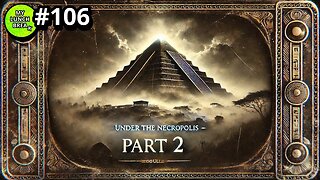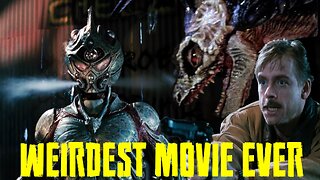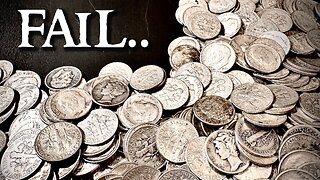Premium Only Content

Building Australia Freedom Tribute to populist podcasters 1
Barnes Brief on Australian Populism from Australia’s Untold Stories
This is a Freedom Edition tribute to my favourite podcasters, VivaFrei (Viva and Barns), America’s Untold Stories (Hunley and Groubert), The Duran, and Bongino. I started following them after 2016, when I was dissatisfied with political analysis following the 2016 election. I wish it that my Freedom Volumes of Bread of Life have introductions inspired by these podcasts. So consider these to be in the style of AUS’s cousins, Skip Hunley and Koala Groubert.
The first volume of Freedom will cover Prehistory to Australia’s Federation. Jan to Apr The second volume will cover Federation to Ming the Merciless. May to Aug The third volume will cover the times from Ming the Merciless to present day 2024. Sep to Dec
First Volume
The story of continental Australia begins some 60 million years ago when the continent separated from Antarctica. This post dinosaur world came about following a 100 million year ice age interlude, from 360 million BC to 260 million BC. Ice ages tend to last that long. The first known ice age lasted 300 million years. The second shortest was 30 million years, during the Andean-Saharan Glaciation beginning 460 million BC. The latest ice age, Quaternary Glaciation, began two and a half million years ago. The last glaciation peak was twenty thousand years ago. Before that peak, ancestors of the Australian Aborigines crossed from modern day south east Asia, through the Indonesian archipelago, and walked to Australia. It probably was not one migration, but several.
Australian Aboriginal peoples populated all of Australia and Tasmania. New Zealand had been populated by pacific peoples separately, over water. Aboriginal tribes people cooked with fire and fashioned tools for their environment (eg boomerang). They missed the farming revolution as the end of the glaciation peak which cut land ties with Asia. They did not have alcohol. They did not make cheese. They were hunter gatherers and would move depending on season. They had no writing. There was no Haka or smoking ceremony. The connection to land was tenuous and depended on what was defensible relative to other tribes, and what was seasonally rewarding.
European age of exploration found Australia a few times.
The first recorded European landings on Australia were made by Dutch explorers in the early 17th century:
Willem Janszoon (1606): Janszoon, a Dutch navigator, was the first European known to land on Australian soil. He landed on the western side of Cape York Peninsula (in what is now Queensland) aboard his ship, the Duyfken, and mapped part of the coastline.
Dirk Hartog (1616): Another Dutchman, Hartog landed on the western coast of Australia (now Dirk Hartog Island in Western Australia) while exploring in his ship, the Eendracht. He left an inscribed pewter plate to mark his visit, which is one of the earliest known European artifacts left in Australia.
Abel Tasman (1642 and 1644): Commissioned by the Dutch East India Company, Tasman explored parts of Australia and New Zealand. On his 1644 voyage, he mapped much of the northern and western coastlines of Australia, which was then known as “New Holland.”
Later, British exploration marked another significant chapter:
William Dampier (1688 and 1699): Dampier, an English pirate and explorer, was the first Englishman to land on Australian soil. He made landfall on the northwest coast in 1688 and returned for further exploration in 1699, publishing his observations and helping raise British interest in the continent.
James Cook (1770): In 1770, Captain James Cook charted the east coast of Australia aboard the Endeavour. He claimed the eastern portion for Great Britain, naming it New South Wales. Cook’s detailed maps and favorable reports spurred British settlement.
These expeditions eventually led to the establishment of British colonies in Australia, beginning with the First Fleet landing in Botany Bay in 1788.
Captain cook had been killed in Hawaii, and the first fleet of Sydney Colony’s foundation in 1789 was captained by Captain Arthur Phillip.
The First Fleet and Second Fleet were pivotal in establishing the colony of New South Wales, which laid the bureaucratic foundation for what became Sydney and, ultimately, modern Australia.
First Fleet (1787-1788)
The First Fleet consisted of 11 ships that departed from England on May 13, 1787, under the command of Captain Arthur Phillip. They arrived in Botany Bay between January 18 and January 20, 1788, before relocating to Port Jackson (Sydney Cove), where they formally established the colony on January 26, 1788.
The First Fleet ships were:
Flagship (Naval Escort): HMS Sirius
Supply Ship: HMS Supply
Convict Transports
Alexander
Charlotte
Friendship
Lady Penrhyn
Prince of Wales
Scarborough
Food and Supply Ships
Golden Grove
Fishburn
Borrowdale
Second Fleet (1790)
The Second Fleet, sometimes called the "Death Fleet" due to the high mortality rate of convicts on board, brought more convicts and supplies to the struggling colony in 1790. The conditions on board were notoriously poor, and around a quarter of the convicts died during the voyage.
The Second Fleet consisted of six ships:
Lady Juliana (transported female convicts, arriving separately in June 1790)
Neptune (arrived June 28, 1790)
Scarborough (arrived June 28, 1790)
Surprize (arrived June 28, 1790)
Justinian (supply ship, arriving June 20, 1790)
Guardian (supply ship, damaged en route and did not arrive in the colony)
Bureaucratic Foundation of the Colony
The bureaucratic foundation of Sydney Colony (initially New South Wales) was established through a mix of military administration and British legal frameworks.
Governor Arthur Phillip was appointed as the first Governor of New South Wales and had nearly complete authority, empowered to enforce British law and maintain order.
Phillip was guided by a set of Royal Instructions and had authority to grant land, discipline convicts, and ensure the colony's survival.
The Judge Advocate (initially David Collins) acted as the colony's chief judicial officer, establishing the framework for colonial justice.
The Court of Criminal Jurisdiction and Court of Civil Jurisdiction were set up to manage legal disputes, overseen by military officers.
Together, these institutions created a functioning government and legal system, laying the groundwork for what would become Sydney and, eventually, the governance structure across Australia.
In 1788, when the First Fleet arrived, it’s estimated that between 300,000 and 1 million Aboriginal people lived across Australia. More recent estimates generally place the figure around 750,000 based on archaeological, linguistic, and historical records.
These Aboriginal Australians were part of a rich and diverse cultural landscape with over 250 distinct tribes or nations. Within these tribes, there were at least 500–600 different language groups or dialects. Each group had its own territory, language, customs, and complex social structures, with deep connections to specific lands, which they managed through sustainable practices honed over tens of thousands of years.
Sydney Colony, initially, found few Aboriginal peoples, but local contacts were peaceful. The relatively recent American colony foundations were known of and Governor Phillip was careful to not antagonise locals. Kitty Randall Reynolds was born in 1770 in the Garigal Clan of the Iyura Nation. She knew herself as Dharuga. She married a second fleeter John Randall Reynolds, who was born in 1764 in New Haven, Connecticut. a daughter named Frances Fanny Aiken - Brown (born Randall Aiken), who was born on October 26, 1792. John Randall Reynolds passed away in 1822, while their daughter Frances lived until her death on October 26, 1870.
Dharuga had had a baby cousin who was adopted by a good family. The boy was raised as a British subject. He excelled in learning, until his mid teens when he discovered alcohol. By age 25, he was drunk while stealing food. There was one penalty for theft, but he was given the option of saying he hadn’t known what he was doing, as he was drunk. He insisted he knew what he was doing and so was hanged. He was the first Aboriginal man executed. It took 25 years before it happened, and authorities had almost begged it not happen. Revisionists claim it was a European style invasion of Australia that was Sydney Colony. They are wrong.
In the early days of Sydney colony, a few convicts escaped and intended to cross the Blue Mountains to the west, and walk north to China. Education wasn’t strong for convicts. One former convict, John Randall became a constable. The marine unit assigned to Sydney Colony was called the Rum corp as they joined in local corruption, trading in Rum. The Rum corp habit of changing seasonal uniforms on the first day of the month was noticed by convicts, and today, Australia and NZ declare the new seasons on the first day of the month, and not equinox or solstice. One other nation in the world has a calendar that starts the season on the first day of the month. But, Israel’s calendar start their months on Equinox and solstice.
The prominent sheep baron in Sydney Colony who frequently clashed with Governor Lachlan Macquarie was John Macarthur. Macarthur was a former British Army officer and one of the leading figures in the colony’s wool industry. He and his wife, Elizabeth Macarthur, are credited with establishing Australia’s merino wool industry, which became a cornerstone of the colonial economy.
Macarthur's disputes with Governor Macquarie stemmed from differences in views on governance and land use. Macarthur was part of the "Exclusives" (wealthy settlers and landowners) who sought greater autonomy and influence in the colony, while Macquarie aimed to create a more equitable society, including providing opportunities for Emancipists (freed convicts). Their rivalry reflected broader tensions between these two social groups in early colonial Australia.
In later times, it was said Australia rode the world on the sheep’s back. In 1818, the first known Chinese migrant came to Australia. His name was Mak Sai Ying. He was a woodworker and he came on the same ship as a brother of the explorer, Blaxland. The Sydney name of Shying originated with Mak Sai Ying. Mak made a linen press for Elizabeth MacArthur, which exists today, last known to be in Milton House. It was, as was the custom of China, made without nails.
If Australia was racist and dismissive of different peoples, Mak didn’t seem to notice. He started an undertaker’s business catering to the wishes of Chinese peoples, before any gold rush. He built and later sold a pub in Paramatta.
Before the federation of Australia in 1901, several significant events shaped New South Wales (NSW) and the other British colonies on the continent. These events laid the groundwork for the eventual unification of Australia’s colonies into a single nation. Here are some key milestones:
1. Establishment of the Colony of New South Wales (1788)
The First Fleet, led by Captain Arthur Phillip, arrived in Port Jackson (Sydney) on January 26, 1788, marking the official founding of the NSW colony. Initially established as a penal colony, it became the first permanent European settlement in Australia.
2. Introduction of the Rum Corps and the Rum Rebellion (1808)
The New South Wales Corps, known as the "Rum Corps" due to their control over the rum trade, grew influential. In 1808, they deposed Governor William Bligh in the Rum Rebellion—the only successful military coup in Australian history. This event highlighted tensions between the military and colonial administration and underscored the need for reform.
3. Governor Macquarie's Reforms (1810-1821)
Governor Lachlan Macquarie implemented major reforms in infrastructure, public works, and the social order, including fairer treatment of emancipated convicts. He encouraged the colony's expansion, urban development, and self-sufficiency, laying a foundation for future growth.
4. Expansion and Establishment of New Colonies (1820s-1850s)
As NSW grew, new colonies were established: Van Diemen's Land (Tasmania) in 1825, Western Australia in 1829, South Australia in 1836, Victoria in 1851, and Queensland in 1859. Each colony developed distinct economies and identities while remaining under British rule.
5. Myall Creek Massacre (1838)
The Myall Creek Massacre, in which settlers killed at least 28 Aboriginal people, was one of the first instances in which white settlers were tried and convicted for violence against Aboriginal Australians. This highlighted the violent conflicts occurring as settlers encroached on Indigenous lands.
6. Australian Colonies Government Act (1850)
The British Parliament passed this act, allowing the colonies to establish their own legislative councils and laying the foundation for responsible government. This led to the creation of the NSW Legislative Council and, eventually, an elected Legislative Assembly.
Sydney University founded to a Cambridge/Oxford model under the motto “Sidere mens eadem mutato" in Latin, which translates to "The stars change, the mind remains the same" in English.
7. Gold Rush (1851)
The discovery of gold in NSW and Victoria in 1851 led to a massive influx of immigrants, wealth, and rapid population growth, boosting colonial economies and fueling infrastructure development. The gold rush era also increased calls for representative government and expanded civil rights.
8. Eureka Stockade (1854)
The Eureka Rebellion in Victoria was an uprising of gold miners against colonial authorities over harsh licensing laws. Although the rebellion was quickly suppressed, it led to reforms in mining licenses and greater democratic representation in Victoria, influencing democratic movements in other colonies.
9. Introduction of Responsible Government in NSW (1855)
NSW achieved responsible government in 1855, gaining the power to elect its own parliament while the British government retained control over defense and foreign policy. This marked a significant step toward self-governance for the colony.
10. National Australasian Convention and Federation Movement (1891-1900)
Throughout the 1890s, representatives from NSW and other colonies met at conventions to discuss unifying as a federated nation. They drafted the Australian Constitution in 1891, which was later revised and put to referendums in each colony, culminating in the decision to federate.
11. Passage of the Commonwealth of Australia Constitution Act (1900)
The British Parliament passed this Act, which created the Commonwealth of Australia, formally uniting the colonies into a single, federated nation. On January 1, 1901, Australia officially became a federation, with NSW and the other colonies becoming states of the Commonwealth.
These events, among others, established political, social, and economic foundations for the federation, as well as a unique Australian identity that emerged from a combination of British influence and colonial experience.
Second Volume
Overview
Between Federation in 1901 and 1965, Australia experienced significant social, political, and economic developments that helped shape its national identity. Here are some key events during that period:
1. Federation (1901)
- On January 1, 1901, six colonies united to form the Commonwealth of Australia. This granted Australia self-governance, although it remained part of the British Empire.
2. Immigration Restriction Act (1901)
- Known as the "White Australia Policy," this legislation restricted non-European immigration and aimed to keep Australia predominantly white. It remained in effect in various forms until it was dismantled in the 1970s.
3. Australian Army's Role in World War I (1914-1918)
- Australia's involvement in WWI, particularly the Gallipoli campaign, had a profound impact on its national identity. Anzac Day (April 25) became a symbol of national pride and remembrance.
4. Australian and New Zealand Army Corps (ANZAC) Day Established (1916)
- ANZAC Day was first observed in 1916, commemorating Australian and New Zealand soldiers' sacrifice, especially those who served in Gallipoli.
5. Women Gain the Right to Vote in Federal Elections (1902)
- Australia became the first country where women could both vote and run for federal office. This move made Australia a global leader in women’s suffrage.
6. Formation of the Commonwealth Bank (1911)
- Established as Australia’s first government-owned bank, the Commonwealth Bank was created to provide financial stability and reduce dependence on British banks.
7. First Radio Broadcast in Australia (1923)
- The first public radio broadcast marked the start of radio broadcasting in Australia, which would become an important medium for news and entertainment.
8. Statute of Westminster Adoption Act (1942)
- This act, passed in 1942 but retroactive to 1939, gave Australia full legislative independence from the United Kingdom, allowing it to make independent decisions on foreign policy and law.
9. Great Depression (1929-1932)
- Australia faced severe economic hardship during the Great Depression. Unemployment reached over 30%, and many struggled financially, impacting the country’s economy for years.
10. World War II and its Aftermath (1939-1945)
- Australia joined the Allied forces in WWII. The Japanese attack on Darwin in 1942 was the first direct attack on Australia, highlighting its vulnerability. Post-war, Australia adopted a more active defense policy and diversified its alliances.
11. The Snowy Mountains Scheme (1949-1974)
- This massive engineering project involved hydroelectric and irrigation development in the Snowy Mountains. It helped diversify the Australian economy and brought in many post-war immigrants, contributing to the multicultural population.
12. ANZUS Treaty (1951)
- Signed between Australia, New Zealand, and the United States, the ANZUS Treaty established a security alliance, marking Australia’s shift towards U.S.-aligned defense policies.
13. Indigenous Affairs and the Stolen Generations
- Throughout this period, policies of forced removal of Aboriginal children, later known as the Stolen Generations, deeply affected Indigenous communities. Awareness and reform in Indigenous rights began to grow, culminating in landmark changes in later decades.
14. The End of the White Australia Policy (1949-1966)
- In 1949, the first steps were taken to dismantle the White Australia Policy, with full abolition completed in 1973. The shift allowed increased immigration from non-European countries, paving the way for a more multicultural society.
15. Menzies Era and Economic Expansion (1949-1966)
- Under Prime Minister Robert Menzies, Australia saw economic growth, expansion of social services, and closer alignment with the U.S. Menzies was Australia's longest-serving prime minister and shaped much of mid-20th century Australian policy.
These events highlight a period of transformation as Australia evolved from a newly federated nation to a modern state with its own cultural and political identity.
==
In depth
The legendary US Deep State exploits are echoed in Australia, as was the journalism divide favouring left wing liberals. NZ had been invited to join the union, but her history and peoples were different. Her Aborigines were Pacific Islanders with an advanced sea faring culture, her colonists were of more Scottish extraction to Australia’s Irish.
A popular conservative politician, George Reid (1845-1919), who was Australia’s fourth PM and later Australia’s High Commissioner to the UK, was faced with a press who attacked him, not his policies. George was very fat. A journalist asked him what he would name his child.
"If it is a girl, I will name her for the Queen. If it is a boy, I will name him after myself. But if, as I believe, it is no more than piss and wind, I will name it after you"
Early Australian political parties took on the UK divide, but the Australian conservatives, dominant, were fractured between Free Trade and Protectionist tariffs. The Australian left wing party named itself after a conservative force, Labor.
Culturally, Australia had European mores. A world class musician, Jacques Jacobs who was conductor of the London Steak house orchestra Trocadero, toured Australia in 1903 and played Sydney, Melbourne and Adelaide. Australia developed writers and poets. Breaker Morant was executed by the British during the Boer War for following British orders. Other poets include Banjo Patterson, Henry Lawson, Judith Wright, Les Murray, Dorothea Mackellar, Bruce Dawe and CJ Dennis.
Aboriginal relations was an issue, as a cargo culture developed and imploded. Churches stepped up to deal with the loss of cultural identity. Education extended on British lines with Bootstrapping from the Lancastrian schools and Madras schools being divided between British foreign office and Catholic church. Disputes between the two systems resulted in modern education as it is today, but also the systems took from each other, and became like. Former Dean of Education at Sydney University, Dr Cliff Turney, noted that the main difference between schools built along either line differed only by how windows were secured. Classrooms all had a raised dais, blackboards and sloped seating facing the blackboards. But, the windows might be very high, with window locks at the bottom, or low, with window locks at the top. What had happened was parents would come to schools during class and encourage their child to climb out the window and go home to work. The locks were positioned to prevent students opening the windows during class time. Coincidentally, British schooling established school summer holidays so children could help with the harvest.
FJ Gladman was raised under the new education system in London, and came to Australia as Inspector General of Education in Victoria. Upon retiring, he wrote “Control and Teaching (1876)” which had lesson plans and timetables for all classes and schools. New teachers were given a class, a copy of the book, and told to teach. A copy of the book was in former Sydney Boys Principal Rodgers, who had been the longest serving Principal in the school’s history by the 1970’s.
With Labor dominating through division, the ‘conservative’ parties merged and called themselves ‘Liberal.’ Over time, the Australian landscape has become conservatives (Liberal) and socialist (Labor), with Greens dragging the Labor party left, and Nationals, representing farming interests, tying the Liberals to the centre, which media describe as ‘extreme right.’
During WW1, when the US conservatives fractured, and Democrats under Wilson, opposed fighting the war until after election, Australian Labor Party figures copied Democrats. Australia was fighting from the beginning, but garnered support by opposing the war, and then, when elected, pivoted. The issue was conscription, and the Labor leader, Billy Hughes had a referendum on the issue in 1916. It was narrowly defeated, and in 1917 passed. However, in getting the bill passed, Hughes fractured the Labor Party, and took his elements into a Nationalist party from the merged Liberal party. Australian resistance to conscription was not opposition to the war, but opposition to the idea that Australians wouldn’t volunteer.
In fighting overseas, an ANZAC corp (Australia and NZ) with a UK force, attacked Gallipolli against Turkey. It had been Winston Churchill’s grand plan to open up Europe from the western front stale mate. It was nearly successful, but relentless press opposition, including Australian Journalist newspaper owner, Murdoch (dad of Rupert), derailed the expedition before success. So that, as ANZAC’s withdrew, there were no fatalities, as the Turks had nearly run out of munitions.
WW1 had resulted in Australia becoming a protectorate of Papua New Guinea.
Lutheran Reverend Karl Strehlow was assigned a parish in central Australia during the late nineteenth century. He came with his wife and had a son. While there, Strehlow became the go to guy for all peoples, for births, deaths and marriages. His respect was legendary, when two warring Aboriginal tribes faced off each other, Karl stood in the center and ordered them to stand down. And they did. When some cattle was stolen, settlers blamed Aboriginals and began randomly shooting them. Strehlow spoke to the police to stop it, and the police did. Much has been made of hate killings and racism in Australia, including a so called ‘Stolen Generation’ but there is no evidence of institutionalised bureaucracy being racist, and no evidence of a stolen generation. Journalist Andrew Bolt has had for the last twenty years an open challenge for the identities ten peoples deemed to be stolen. His challenge remains unmet. Most claims to being part of a stolen generation seem tragic cases of community dislocation where the church has stepped up to care for the lost. Also authorities have a vested interest in claiming racism being historical. It differs, even, from the US where no political party in Australia ever benefited from racism as Democrats did in the US. Although xenophobic ALP would later be instrumental in Japan opposing the West after WW1 armistice agreements opposed a “yellow Perile” as ALP (Labor) supporters viewed them.
Later in his life, Strehlow diagnosed himself with heart disease. He could get treatment in Adelaide, but his swelling made it too challenging to take the journey by cart. He needed a car. Authorities refused his request and so the entire community packed and journeyed with Strehlow’s family to Adelaide by cart. Strehlow died partway through the journey, at Horseshoe Bend, and his 14 year old son would grow up to be an anthropologist and write a biographical story “Journey to Horseshoe Bend.”
ALP would never, historically, have approved lynching of Aboriginal peoples, but they were racist in other ways. The White Australia Policy was begun by them and ended by their opposition. In much the same way Democrats supported slavery in the Civil War and opposed GOP attempts to dismantle it.
A conservative, Menzies could not get a fair go in the press with reporting, even after becoming PM. Australia created an unbiased Australian Broadcasting Corporation ABC, but they hired journalists who worked to policy. Even when WW2 ended, a lone Japanese soldier on a deserted island, with a radio for outside contact which only connected to the ABC, kept fighting until the 1970’s. He hadn’t known the war was over.
World War 2 began with Australia having a conservative PM, Menzies, sharing power under a government of unity. Just like the UK, the Labor party undermined the war effort through a mixture of labour union strikes and collusion with the press. Menzies had been in Europe and ANZAC’s fought at Tobruk (desert rats) and Jacob’s Well with distinction. A new Labor government had those troops withdrawn and stranded them in Singapore. Japan advancing through PNG and Australia’s forces were comprised mainly of newly trained 18 and 19 yo troops. MacArthur provided a steady hand and coordinated a war effort from Australia. PNG troops had been supported by native PNG peoples because they weren’t racist, as Japanese had been.
At wars end it was decided that not everyone who fought for the axis should face recriminations. The Thai authors of the Burma Railway were never held to account for their atrocities. Labor government delayed liberating POWs. Australia remained under food restrictions as farmers were off fighting. But government control increased and there was a bureaucratic attempt by ALP to nationalise the Commonwealth Bank. Control of banks were a longtime dream of the ALP, NSW Premier during the building of the Sydney Harbour bridge had tried to withdraw all the gold in the banks so UK would not be paid for their loan. A harbour bridge toll, intended to pay the loan, still exists 90 years after the bridge was opened, and five decades after the loan was paid off.
Such lawlessness was not rewarded by Australian voters, and Menzies again became PM from 1949 until he left office in mid 60’s. Menzies lowered regulation, expanding the economy, brought in civil rights, ended the White Australia Policy and prevented the exclusion of Aboriginal Peoples from an apartheid like existence. The ALP would revise history to claim their people did things, but they basically postured on issues.
Third Volume
Here is a summary of key events in Australia from 1965 to 2024, covering social, political, and economic developments:
1960s - 1970s
1. Abolition of the White Australia Policy (1966-1973)
- Gradual policy changes under Prime Ministers Harold Holt and Gough Whitlam dismantled the White Australia Policy, opening the nation to more diverse immigration.
2. 1967 Referendum on Indigenous Rights
- Australians voted overwhelmingly to amend the Constitution to allow the federal government to make laws for Indigenous Australians and include them in the census, marking a significant step toward Indigenous rights.
3. Vietnam War and National Service (1965-1972)
- Australia participated in the Vietnam War, leading to widespread anti-war protests. Conscription became a divisive issue, eventually ending in 1972.
4. Establishment of Medicare (1975)
- The Whitlam government introduced Medibank (now Medicare), a universal healthcare system, ensuring accessible health services for Australians.
5. Dismissal of Prime Minister Gough Whitlam (1975)
- In an unprecedented event, Governor-General Sir John Kerr dismissed Prime Minister Whitlam, leading to a constitutional crisis.
1980s - 1990s
6. Floating of the Australian Dollar (1983)
- Under Prime Minister Bob Hawke and Treasurer Paul Keating, the Australian dollar was floated, allowing market forces to determine its value, transforming the economy.
7. Bicentennial Celebrations (1988)
- Australia celebrated 200 years since the First Fleet's arrival, sparking discussions about the country's colonial history and its impact on Indigenous Australians.
8. Native Title Act (1993)
- Following the landmark Mabo case, which recognized native title, the Native Title Act allowed Indigenous Australians to claim land rights.
9. Introduction of the Goods and Services Tax (GST) (2000)
- Prime Minister John Howard introduced a 10% GST, restructuring Australia’s tax system.
2000s - 2010s
10. Sydney Olympics (2000)
- Australia hosted the Summer Olympics in Sydney, showcasing Australian culture and strengthening the nation's global reputation.
11. Australia’s Involvement in Iraq and Afghanistan (2001-2013)
- Australia joined the US-led interventions in Iraq and Afghanistan, aligning with American foreign policy.
12. Apology to the Stolen Generations (2008)
- Prime Minister Kevin Rudd formally apologized to Indigenous Australians for the Stolen Generations, addressing past injustices.
13. National Broadband Network (NBN) Launched (2009)
- The NBN project aimed to provide high-speed internet across Australia, modernizing digital infrastructure.
14. Same-Sex Marriage Legalization (2017)
- Following a national postal survey, same-sex marriage was legalized, reflecting societal changes and progress on LGBTQ+ rights.
15. Australia’s Role in Climate Change (2000s-Present)
- Australia has been a key player in global climate discussions, with significant events including the Kyoto Protocol ratification (2007), the 2011 Carbon Tax, and debates over emissions reduction targets.
2020s - Present
16. Bushfires and Natural Disasters (2019-2020)
- The "Black Summer" bushfires devastated vast areas, highlighting climate change's impact and sparking policy discussions on environmental management.
17. COVID-19 Pandemic (2020-2022)
- Australia enforced strict lockdowns and quarantine measures, achieving relatively low infection rates. The pandemic led to economic stimulus packages and policy changes on healthcare and social support.
18. Formation of AUKUS Alliance (2021)
- Australia, the UK, and the US formed AUKUS, a defense pact focused on Indo-Pacific security, marking a shift in Australia’s strategic alliances.
19. Voice to Parliament Referendum (2023)
- A referendum was held to decide on the establishment of an Indigenous Voice to Parliament. Although unsuccessful, it sparked further discussions on Indigenous representation.
20. Ongoing Climate Initiatives and Renewable Energy (2020s)
- Australia has continued investing in renewable energy, including large-scale solar and wind projects, moving toward net-zero emissions goals by 2050.
These events have been critical in shaping Australia's national identity, political landscape, and societal values from 1965 to 2024.
=
In Depth
Australia’s electoral system was built to be different to USA. One difference is voting is compulsory in Australia. The big difference, results in a different way of electioneering. Australian politicians don’t need to convince those who agree with them to vote, so instead they cross the divide and claim to represent the so called ‘centre’, or, ‘everyone.’ That is one reason why the ALP chose ‘labor’ and Menzies chose ‘liberal’ as their party names. So, in the US, a series of primaries allow candidates to gather supporters, Australia does not have that. And so, while an election may give an Australian leader a mandate, even an effective leader can be rolled by opportunists.
Tony Abbott was an effective leader and elder statesman of world politics when he made moves to assert a position in the wake of a Malaysian passenger airplane shot down in Ukraine by Russian patriots. Joe Biden’s role in the tragedy is never discussed in the media, but US signals intelligence tracked the Russian Patriots call to Moscow when they admitted their error. All might seem par for the course until one asks why Ukraine had been ‘painting’ their military aircraft with civilian identifiers preceding the error. Obama had locked the west in opposition to Russia, but it was Ukraine which had initiated the war crime, and Abbott got called in to settle tensions, which he did. Abbott had had a daughter who had taken the same flight a week before. It was, by Ukraine an act of terror. Biden exploited it. Obama ducked.
Not long after, Abbott’s political opponent within his own party connected with Hilary Clinton and launched a campaign against Abbott, alleging misogyny. As a US based journalist denounced Abbott for being anti female, Turnbull did nothing, but every state Liberal party polled the issue and the decision was made “Women would not vote Abbott.” And so Abbott, whose senior public servant was female, who was a family man, with daughters, and a loving wife, was rolled for Turnbull. While Australia subsequently paid $millions to the Clinton foundation, that resource for Turnbull was spent.
Welcome to politics, Australian style. Where extremist left wing Green policy is deemed responsible by the press, and centre left politics of the conservative party is called ‘Lunar Right.’
Australia has a right wing, but it is not formalised into a functioning party. Tommy Robinson, following the UDL (Ulster Defence League) nomenclature created an EDL in England, and Australians formed an ADL (not to be confused with the US version with the same letters). ADL sought US political money, but knew their ADL name was toxic, so they called themselves the Australian Tea Party.
In 2010 a trucker’s convoy was organised and ADL backed an individual to be the face of it after the fact. That individual took over. That individual then took over a branch of a political party and became an agent of influence for the ADL in that party, their apparent job to sew division. Normally, a branch measures success by fundraising, but the party wanted an organiser.
Party politics is ugly in Australia, and sometimes disgusting. A popular PM, Bob Hawke had risen the ranks of Labor through trade unions. As trade union chief he was famous for his beer drinking, once throwing up live on air. The son of a religious minister, he was an atheist but could negotiate with anyone. During a visit to the UN, Hawke, representing Australia, told a joke. “A raffle was held in India, cheap to enter and with magnificent prizes, everyone got themselves tickets. Come the day of the draw, third place was drawn first. And so a poor Indian man won a BMW. Second place draw, and a man, wondering what beats a top of the line European car went to get his prize. It was a beautiful cake. “A cake, is that all I get when the other won a BMW?” “This is a special cake, baked by Mother Teresa.” “F@ck Mother Teresa” “No, no no. That is first prize.”
The ALP are the party of exploitation of Australian minorities. When communists were the ‘enemy’ in the ‘50s, ALP aligned to be reasonable and garner sympathy. During the so called peace marches against fighting in Vietnam, ALP were the first to demand understanding. When ALP PM Gough Whitlam took power in 1972, his first act was to abandon anyone in Vietnam that had believed the assurances and promises made to them. It was a scene similar to US withdrawal from Afghanistan. It was made without thoughtful planning. The result was when South Vietnam imploded a month after US withdrawal, Unified communist Vietnam had a surplus of US weapons. They offered to sell those weapons to the highest bidder, including Timor. Gough gave tacit approval for Indonesia to invade Timor, taking the lives of five journalists in Balibo. Despite the humanitarian crisis, Gough did nothing for Timor, Vietnamese peoples fleeing Vietnam crossed the ocean to get to Australia. An estimated 50% died making the journey on coastal vessels unsuited to open waters, and subjected to piracy from Chinese vessels.
Not every conservative Liberal leader s good, but no ALP leader is worthwhile. Malcolm Frazer (Liberal), was over ruled by his colleagues who helped Vietnamese refugees when nations like Malaysia were machine gunning refugees on beaches.
The issue of Aboriginal identity was exploited by the ALP. Government bodies were set up in which people who were Aboriginal by choice dominated. In the mid ‘80s, while ALP were adjusting the educational sector by merging technical and further education into universities, whereby nurses and teachers who used to get Diplomas had to get degrees, but the courses remained the same. An Aboriginal elder from Northern Territory met with a chairman of the academic board of a Sydney University, asking for his people to get a modern education for jobs. Instead, the government inflicted on all Australian children a black armband view of Australia, with Sydney Colony being an invasion force. All Australian children are told that Aboriginal Culture means individuals cannot become Australian. That myths made up by anthropologists must be blindly accepted.
A beautiful tale of resilience and survival came out of the ‘80s. Called Rabbit Proof Fence, it told the story of three Aboriginal children who had been abandoned in Western Australia. They were given foster care in Melbourne, but were homesick. They followed the Rabbit Proof Fence around the south coast of Australia for thousands of miles. They passed homesteads of settlers who gave them aid and facilitated their journey. They travelled the length off Australia, met strangers who showed love and didn’t molest them. Hollywood made a movie out of the story. In the movie, the girls were not in foster care but a kind of juvenile detention with prison garb. They are chased by authorities with guns and hunting dogs. The movie is required watching for all school children in Australia as part of te curriculum.
In the 80’s ATSIC (Australia and Torres Strait Islanders authority) authorised a ‘tent embassy’ in Canberra. A campaign gathered speed. After Liberals had ended White Australia Policy, ALP needed to trump that card, and the campaign was to publicly say ‘Sorry’ to Aboriginal peoples. Land rights were also an issue. Instead of mining for profit, it was conceived that miners would be charged rent.
A story arose of the Great Barrier reef dying from AGW. Only it is growing every year. But scientists are punished for saying so. Nonsense regarding power generation pervades public policy, so all of the ALP promote unsustainable energy sources and oppose sound energy practice. Yet the best wind power generator in 2010 has a twenty year working life (optimally) and costs 100k Euro more than it produces in its working life.
Corruption is endemic among the judiciary who do not respect the constitution or legislation that guides them. When land rights resulted in Mabo, the High Court of Australia claimed they could ‘read between the lines’ of the constitution. When Malcolm Turnbul found his Deputy PM, Barnaby Joyce, inconvenient, the High Court claimed that Joyce, born in Tamworth of NSW, was actually a NZ citizen because his grandfather had been born there before it became a nation. And the Deputy PM’s position was declared vacant and Joyce got re=elected.
However, corruption is much older, and much worse than what it seems. In the early ‘90s, paedophilia was raised as an issue that NSW needed to address as a state. The Premier’s ALP party had division where senior ranking members were leaking to the press. A royal commission into police practice, with the possibility of protecting paedophiles was being investigated, branched into teaching. The NSW Independent Commission Against Corruption (ICAC) is loath to investigate ALP figures. There was lots of name calling, but eventually it was decided the issue had settled. Then an issue arose at a metropolitan high school in an ALP area.
Special powers were given the coroner, who no longer needed to report a truth, but was sanctioned to include stakeholders. When Michael Hutchence died from apparent auto erotic misadventure, the coroner was allowed to report that it had been suicide. And so school girls felt better about the whole ordeal. A report was made about paedophilia in the school and an investigation was bungled. The teacher who reported appropriately within the department was transferred to another school. But, teachers of the other school were gien the innocen teacher’s identity. The innocent party reported of a child who suffered from anaphylaxis from peanuts. The child had told many people. The next year, the child was on an excursion where they were challenged to lick peanut butter from a spoon. Having been humiliated by their peers while talking of their condition, one imagines he thought he would get sick and the teacher would get into trouble. Instead he died in seconds, and the coroner placed partial blame on the parents not warning the school, as they had. In covering up the incident, a law was made in some places across the world, banning peanut butter from use in schools, churches and child care centres. The issue was raised in NSW parliament and copied into record of Hansard, but the government delayed it until it was out of office. Parliament does not investigate itself and any inquiry was dead.
There are no greater nations than Australia. In 1975, legislation was passed to allow all workers in Australia who work full time to get four weeks annual leave. This would help the economy with Australians holidaying in Australia. However, it was pointed out that wage earners who worked overtime might miss those hours. So a survey was done and it was found that the average overtime worked by employees was 17.5%. So, every wage and salary earner gets four weeks annual leave with leave loading. Nowadays, overtime rates are at fifty percent, but no one is insisting on that being a new leave loading.
-
 45:06
45:06
Current Affairs and world politics
1 year ago $0.20 earnedThe sad lives of the Daughters of Mary Wollstonecraft
2845 -
 15:34
15:34
Misha Petrov
12 hours agoReacting To TikTok’s Most DELUSIONAL Takes!
1.29K5 -
 1:52:24
1:52:24
Squaring The Circle, A Randall Carlson Podcast
1 day ago#032 Flournoy Holmes' Artwork Helped Define The Southern Rock Phenomenon of The Early 1970's
1.83K2 -
 19:56
19:56
inspirePlay
1 day agoWalking with Lions & Facing Africa’s Wild Side | Safari Adventure with the Grid Championship Crew!
7 -
 10:50
10:50
RTT: Guns & Gear
1 day agoBudget Friendly Carry 2011: EAA Girsan Brat 2311
2181 -
 3:49:06
3:49:06
Alex Zedra
13 hours agoLIVE! New Game | Nuclear Nightmare
87.1K11 -
 25:08
25:08
MYLUNCHBREAK CHANNEL PAGE
1 day agoUnder The Necropolis - Pt 2
270K61 -
 1:45:59
1:45:59
Spittin' Chiclets
1 day agoCanadian Chokejob - Game Notes Live From Chicago - 12.28.2024
251K31 -
 9:18
9:18
Space Ice
22 hours agoThe Guyver - Alien Bug Suits, Exploding Dragons, & Mark Hamill - Weirdest Movie Ever
159K26 -
 9:31
9:31
Silver Dragons
1 day agoSilver Has Failed - Can it Set the Record Next Year? THIS BANK SAYS YES!
1.44K2